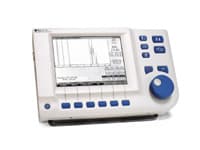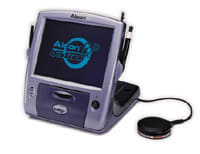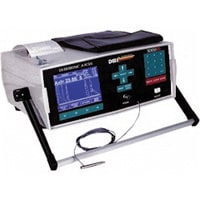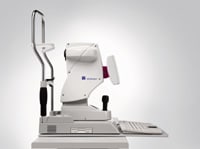Sizing Up Your Biometry Options
Experts discuss the evolution of this technology at a time when its precision is paramount.
BY JOHN PARKINSON, ASSOCIATE EDITOR
Inaccurate IOL power, by way of off-target axial length measurement, has long been a leading reason for IOL explantations. But in this era of demanding patients and sophisticated IOLs, missing the mark with biometry is no longer acceptable. It's also much less likely given the availability of newer instruments and techniques.
With this in mind, we asked experts to comment on the latest developments and their experience with the instruments in this product category.
Overall Enhancement Plus Fine-Tuning
"I think we have gotten to a time where most of these ultrasounds are pretty accurate, so the overall quality has improved," says Kenneth J. Hoffer M.D., F.A.C.S., clinical professor at the Jules Stein Eye Institute at U.C.L.A., and clinical practitioner at St. Mary's Eye Center in Santa Monica, Calif.
In the past, Dr. Hoffer explains, disparities between biometers existed. He uses the example of ultrasound instruments that used to measure the entire length of the eye in one pass using an average speed versus those that measured the various parts of the eye separately.
Dr. Hoffer feels the latter approach has been more useful for measuring both long and short eyes because the average speed of sound is different in different types of eyes. Consequently, he has noticed more instruments on the market that address this issue.
Rhonda Waldron, MMSC, COMT, CRA, ROUB, RDMS, diagnostic echographer and senior associate in ophthalmology at the Emory Eye Center at Emory University, cites scleral spike recognition software as one improvement that can really help doctors and technicians.
"Many physicians and technicians haven't been trained in how important it is to have a separate scleral spike posterior to the retinal spike to ensure alignment," states Waldron. "If the scleral spike is absent, the alignment is along the optic nerve rather than the macula. There are some manufacturers who now have their units programmed not to lock on a spike pattern in which the scleral spike is absent."
Partial Coherence Interferometry: Dominant or Complementary?
Possibly the biggest change in biometry in recent years has been the introduction of the IOL Master, which measures axial length, corneal radii and anterior-chamber depth using noncontact partial coherence interferometry. Along with the immersion ultrasound technique, partial coherence interferometry has rendered the applanation method obsolete when calculating a highly accurate IOL power is the goal.
"I think all cataract surgeons should be using immersion or partial coherence interferometry," says Mark Packer, M.D., clinical assistant professor at the Casey Eye Institute at Oregon Health & Science University, and principal in the practice Drs. Fine, Hoffman, & Packer. "There is really scant defense for applanation anymore given the refractive demands of our cataract patients, our refractive lens exchange patients and even more so, the patients who have already had refractive surgery once."
As more doctors adopt the IOL Master, it leads to the question of whether this technology will be the dominant biometry method or a complementary method.
Doctors and other experts tout the technology for creating very accurate readings, simplifying the process, and standardizing the procedure. "There is less of a learning curve for the IOL Master than for ultrasound-based biometry," states Warren Hill, M.D., principal in Arizona-based East Valley Ophthalmology.
Conversely, Waldron says that being able to carry out the immersion technique doesn't take as long to learn as some may think. In her experience, it generally takes one day of training and some practice to become competent.
As far as practice management, Dr. Hill also believes the ease of use and speed of the IOL Master can help practices with patient flow. And while he believes most patients are compatible candidates for the IOL Master, he points to two particular groups who can benefit.
"The patients who seem to benefit the most from optical coherence biometry are those for whom the refractive outcome is a critical part of the surgical procedure, such as those patients receiving an accommodative or pseudoaccommodative intraocular lens, and patients with certain specific occupational requirements such as pilots," says Dr. Hill.
Dr. Packer mentions another type of case where optical coherence is likely an advantage: "There may be an advantage to the IOL Master with highly myopic eyes with posterior staphyloma in which you can't be sure that you are measuring to the fovea." For practices that don't have an IOL Master, this can be remedied with the use of a B Scan.
Jack Holladay, M.D., M.S.E.E., F.A.C.S., clinical professor of ophthalmology at Baylor College of Medicine and president of Holladay LASIK Institute, sees three advantages to using partial coherence interferometry. "It's at least one order of magnitude more precise than ultrasound," says Dr. Holladay. "It measures optical axial length from the corneal vertex to foveola rather than the anatomical axial length which covers from the anterior corneal vertex to posterior pole which is nasal to the foveola," explains Dr. Holladay. "And the third advantage of the IOL Master is that it actually measures and includes the thickness of the retina whereas ultrasound measures to the front of the retina and we add a nominal value of 200 microns for retinal thickness."
Optical coherence measures from the corneal vertex to Bruch's Membrane, and the IOL Master captures readings by having the patient fixate on a target.
However, everyone agrees there are situations where A-Scan ultrasound should be the method of choice. "Optical coherence is limited in that it cannot measure through dense nuclear cataracts, PSC cataracts, and other media opacity such as corneal edema or scarring or vitreous pathology. Nor should it be used when a patient has trouble fixating," explains Waldron. She says that too many practices use the contact method when patients cannot be measured by optical coherence, and the contact technique is a lower standard of care compared with immersion, and ultimately unfair to those patients.
Nonetheless, Waldron still sees great value in optical coherence biometry, stating it is the most patient-friendly of all techniques, and pointing out its ability to capture readings as fast as immersion biometry.
She sees both optical coherence and immersion as viable techniques.
"The IOL Master is complementary technology to immersion ultrasound machines since both utilize noncontact instrumentation and are so highly accurate," says Waldron.
Measurable Improvements
While everyone has his or her preferred technique and brand of instrument, overall, everyone agrees that biometric technology has become simpler to use, creates reproducible results, and when used properly is more accurate than ever, which means it benefits patients and streamlines practice management as well.
|
Today's Instruments |
| Here is a sampling of some of the biometers that are available in the market.
This machine is equipped with waveform analysis -- digital signal analysis -- which helps to ensure quick, precise measurements. Patient management is simplified because the instrument can store up to 100 patients' data and link the information to a PC. According to the company, custom eye types and material velocities can be programmed.
Engineered to enhance patient care by providing high-quality A-Scan biometry and pachymetry readings, this ultrasound system represents a unique combination of ergonomics and advanced technology according to Alcon. It delivers the accuracy needed and reliability demanded in a lightweight design. The OcuScan RxP makes it simple to obtain accurate and reproducible measurements for all your patients.
According to the company, this biometer has the unique feature of corneal compression detection software. If too much pressure is placed on the cornea, an error message appears rather than a too-short reading. The A-Scan has water immersion as an option. A large LCD displays live waveforms. There is a built-in printer and its formulas include: Binkhorst, SRK/T, SRK II, and Holladay I formulas.
This high-resolution A/B-scan instrument includes training by credentialed clinical applications specialists. Both immersion and contact A-scan biometry may be performed using multiple IOL formulae: Holladay, SRK/T, Hoffer-Q, and Haigis Optimized.
Quantel says the Axis II PR offers the same precision, features, formulas and ease of use as the Axis II Precision A-Scan, but that it also addresses the challenge of measuring post-refractive patients by providing six post-refractive formulas with established clinical efficacy equivalent to the laser interferometer. It now calculates IOL powers in .25-diopter increments .
The IOL Master is the first noncontact instrument that measures axial length, corneal curvature, anterior chamber depth, and white-to-white (optional). An integrated lens constant optimization program allows for efficient personalization to enhance outcomes.
|














